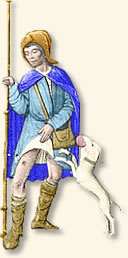What were the symptoms of the Black Death?
There we three forms of the plague. These included the Bubonic plague; which was the most common of the three, as well as the Pneumonic Plague and the Septicemic Plague.Bubonic Plague
Victims of this plague would usually only still be living for five days, if not less.
 The first symptom was painful swellings (buboes) that appeared in the victims' armpits or groin. From there, they would develop a fever, as well as large headaches and chills. The buboes would cause bleeding underneath the skin, which would turn the surrounding area blue or purple. Closer to death, the plague would attack the nervous system, causing the victim to suffer body spasms, or seizures. If the buboes burst, black liquid would ooze out of them and the victim may live.
The first symptom was painful swellings (buboes) that appeared in the victims' armpits or groin. From there, they would develop a fever, as well as large headaches and chills. The buboes would cause bleeding underneath the skin, which would turn the surrounding area blue or purple. Closer to death, the plague would attack the nervous system, causing the victim to suffer body spasms, or seizures. If the buboes burst, black liquid would ooze out of them and the victim may live. The image on the right shows a man revealing a buboe on his leg. From a 14th illumination.
Pneumonic Plague
Most victims of this plague would only survive up to three days. There wasn't any buboes, however they suffered from severe coughing and chest pains, the fever, usually had difficulty breathing and would cough up blood. Barely anyone would recover from the peumonic form.
Septicemic Plague
Victims of this form of the plague would die the most swiftly, and symptoms won't often appear before their death. However, victims may have experienced abdominal pain, nausea and bleeding due to blood clotting problems.

-The Decameron, Boccaccio
http://www.umm.edu/ency/article/000596sym.htm
http://historymedren.about.com/od/theblackdeath/a/death_defined.htm
http://www.historylearningsite.co.uk/symptoms_plague.htm
http://www.eyewitnesstohistory.com/plague.htm
Good. A primary source image of a plague sufferer - with buboes - would enhance this section too.
ReplyDeleteGreat to see this was followed up.
ReplyDelete